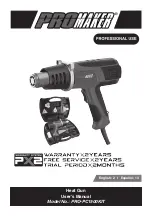
13
GCE 6-EC
Do not run the power tool while carrying it at your side.
Accidental contact with the spinning accessory could snag
your clothing, pulling the accessory into your body.
Regularly clean the power tool’s air vents.
The motor’s
fan will draw the dust inside the housing and excessive ac-
cumulation of powdered metal may cause electrical ha-
zards.
Do not operate the power tool near flammable materi-
als.
Sparks could ignite these materials.
Do not use accessories that require liquid coolants.
Using water or other liquid coolants may result in electrocu-
tion or shock.
Kickback and Related Warnings
Kickback is a sudden reaction to a pinched or snagged rotating
wheel, backing pad, brush or any other accessory. Pinching or
snagging causes rapid stalling of the rotating accessory which
in turn causes the uncontrolled power tool to be forced in the
direction opposite of the accessory’s rotation at the point of the
binding.For example, if an abrasive wheel is snagged or pin-
ched by the workpiece, the edge of the wheel that is entering
into the pinch point can dig into the surface of the material cau-
sing the wheel to climb out or kick out. The wheel may either
jump toward or away from the operator, depending on direction
of the wheel’s movement at the point of pinching. Abrasive
wheels may also break under these conditions. Kickback is the
result of power tool misuse and/or incorrect operating procedu-
res or conditions and can be avoided by taking proper precau-
tions as given below.
Maintain a firm grip on the power tool and position
your body and arm to allow you to resist kickback
forces. Always use auxiliary handle, if provided, for
maximum control over kickback or torque reaction du-
ring start-up.
The operator can control torque reactions or
kickback forces, if proper precautions are taken.
Never place your hand near the rotating accessory.
Accessory may kickback over your hand.
Do not position your body in the area where power tool
will move if kickback occurs.
Kickback will propel the tool
in direction opposite to the wheel’s movement at the point
of snagging.
Use special care when working corners, sharp edges
etc. Avoid bouncing and snagging the accessory.
Corners, sharp edges or bouncing have a tendency to snag
the rotating accessory and cause loss of control or kick-
back.
Do not attach a saw chain woodcarving blade or too-
thed saw blade.
Such blades create frequent kickback
and loss of control.
Safety Warnings Specific for Sanding
Do not use excessively oversized sanding disc paper.
Follow manufac-turers recommendations, when selec-
ting sanding paper.
Larger sanding paper extending
beyond the sanding pad presents a laceration hazard and
may cause snagging, tearing of the disc or kickback.
Additional safety instructions
Use only extension cables permitted for outdoor use.
It is not recommended to sand lead paint. Lead paint should
be removed by a specialist only.
If plaster board or plaster is sanded, this may cause static
electricity to build up on the tool. To ensure your safety, the
wall sander is earthed.
Remove dust with an earthed dust extractor only.
Do not work on materials which release hazardous sub-
stances (e.g. asbestos). Take precautions if hazardous, com-
bustible or explosive dust is likely to occur. Wear protective
dust mask.
Use dust extraction system.
Noise and vibration
Overview (Figure A)
1
Sanding head
with closed brush ring
2
4.0 m power cord with plug
3
32 mm connection
4
Tool change head
5
Handle
6
Switch rocker
Switches the power tool on and off.
With notched position for continuous operation.
7
Dial for preselecting the speed
8
Suction hose
9
Orbital sander head
10
Sanding head
with open brush ring for sanding edges
11
Delta sander head
12
Fastening screws
13
Orbital Velcro plate
14
Brush ring
15
Screw
16
Retaining washer
17
Velcro pad
18
Backing pad
19
Replaceable protective corners
20
Delta Velcro plate
Damage to property!
The mains voltage and the voltage specifications on the rating
plate must correspond.
NOTE
Values for the A-weighted sound pressure level and for the
total vibration values can be found in the table on page 6.
The noise and vibration values have been determined in accor-
dance with EN 60745.
CAUTION!
The indicated measurements refer to new power tools. Daily
use causes the noise and vibration values to change.
NOTE
The vibration emission level given in this information sheet has
been measured in accordance with a standardised test given in
EN 60745 and may be used to compare one tool with another.
It may be used for a preliminary assessment of exposure. The de-
clared vibration emission level represents the main applications of
the tool. However if the tool is used for different applications, with
different accessories or poorly maintained, the vibration emission
may differ. This may significantly increase the exposure level over
the total working period.
However if the tool is used for different applications, with different
accessories or poorly maintained, the vibration emission may dif-
fer. This may significantly decrease the exposure level over the to-
tal working period.
Identify additional safety measures to protect the operator from the
effects of vibration such as: maintain the tool and the accessories,
keep the hands warm, organisation of work patterns.
CAUTION!
Wear ear protection at a sound pressure above 85 dB(A).
Содержание GCE 6-EC
Страница 1: ...GCE 6 EC ...
Страница 3: ...3 ...
Страница 4: ...4 ...
Страница 5: ...5 ...
Страница 130: ...502 278 07 2020 Für Druckfehler keine Gewähr Technische Änderungen vorbehalten ...














































